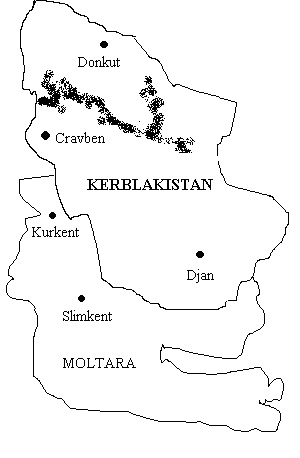

The country known as Kerblakistan today traces its roots back several thousand years as part of ancient Mesopotamia. It was the most Eastern lands in the region. It has been conquered by various ethnic groups over the centuries and present-day Kerblaks trace their roots back to the ancient Arameans. The Molvanians first arrived at the lands of the Kerblaks only a few centuries ago. Although a minority, they possessed industrial and financial know-how that allowed them to dominate political, economic and social life in the land. This, combined with their different religious beliefs and language (they use the Roper script for writing), meant that they were seen as rivals with the Kerblaks. Eventually, the Molvanians settled in the Moltara region of the country in which they constituted an ethnic majority. The ethnic Slobovian group has always existed in the lands but after the annexation of Kurkent in the 1928 Prost Treaty, their numbers dramatically increased. Although similar to the Molvanians, they speak a different dialect and practice the same religion as the Kerblaks. They have claimed since the annexation of Kurkent that they have been subject to ethnic prejudice at the hands of the Molvanians and the Kerblaks. Many have sought the return of Kurkent back to Slobovia.
Modern-day Kerblakistan has had several ethnic clashes among the various groups which has made governing very difficult. Slobovians have campaigned to have Kurkent back to Slobovia while many ethnic Molvanians in Moltara have demanded that Moltara secede from Kerblakistan. Differences in language, religion and history have made it difficult for the groups to find a common group. The previous Kerblakistan constitution has been rejected by all parties for either entrenching interests or giving away too many rights. The current constitutional convention called by the government hopes to craft a constitution to overcome the significant differences among the various ethnic groups.
Population: 7.2 million (July 2020 census)
Population Growth: -.3% annually
Life Expectancy: 61 years old (average female/male)
Ethnic groups: 62% Kerblaks, 30% Molvanians, 7% Slobovians and 1% other. The majority of ethnic Kerblaks occupy Kerblakistan proper with the Molvanians a majority in the region known as Moltara and Slobovians concentrated around the town of Kurkent..
Literacy (age 15 and above): 60%
Capital: Donkut (2.9 million)
Other Major Cities: Cravben (1.2 million) and Slimkent (1 million)
Size: Approximately 33,700 square kilometers
Labor force: Over 35% of the labor force is engaged in agriculture, and 20% of the labor force is involved in the industrial sector
Economics: Agriculture provides 40% of GNP
Political History: Please see here.
*Centre for Information and Analysis Factbook. 2021. Boca Raton: Roper Disinformation Publishers.